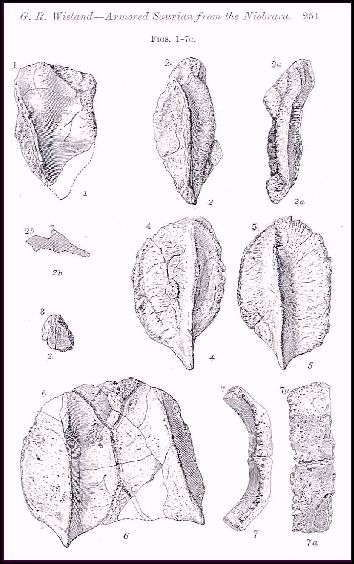
Charles H. Sternberg
1909
An armored dinosaur from the Kansas chalk
Transactions of the Kansas Academy of Science, 22:257-258
Read at the 41st Annual Meeting of the Kansas Academy of Science
Dec. 31, 1908 - Jan. 2, 1909
Wherein Charles Sternberg reports the discovery of the remains of only the second dinosaur to be found in Smoky Hill Chalk up until that time. The first Kansas dinosaur remains were discovered by the Yale Scientific Expedition and O. C. Marsh in 1871
See more about Charles H. Sternberg here.
|
Geological Papers.
257
AN ARMORED DINOSAUR FROM THE KANSAS CHALK. By CHARLES H. STERNBERG. Lawrence. L AST February Barnum Brown, of the American Museum of Natural History staff, published a description for the first time of his wonderful armored dinosaur, which he named Anchylosaurus magniventris, representing a new family, genus, and species. It was discovered in 1906 by the American Museum expedition in "The Hell Creek Beds of Montana." It represents, he says, a group of Stegosauria, characteristic of the late Cretaceous of this country.The skull is entirely covered with plates, which are coössified in continuous surface, and cover top and sides of the head. Some thirty dermal plates were discovered, and in their restoration they and others are arranged in parallel rows along the "entire back and sides of the reptile. They are diamond-shaped, with the sharp angles rounded off, while the center is thickened into an elevated wedge-shaped crest. In his restoration the interspaces were left naked, as he evidently had none of the connecting smaller and various shaped bodies to completely fill all the interspaces. In 1905, while conducting an expedition in the Kansas Chalk, I discovered the broken-up skeleton of what I considered a large new sea-tortoise with an ossified carapace. It attracted my attention, and I knew it was new, but as it was weathered and detached from its matrix I concluded it could not be used and left it there. Later, my son George brought into camp, a few miles from Hackberry creek, where I had found my specimen, some peculiar plates like the ones I have already mentioned; but as I had no knowledge of Barnum Brown's discovery, I concluded they were the neurals of a new turtle. These I sent on to Dr. G. R. Wieland for description. Last month I was his guest at Yale University museum. He asked me why I thought it a new turtle. After giving my reasons, he told me it was new enough, but these plates were the dermal scutes of an armored dinosaur. Later I secured the skeleton, through the efforts of my son, who found them as I directed. I went over the mass of fragments, and separated the armor, and found that the entire skeleton was covered with a completely coossified dermal covering, in most beautiful patterns, the larger scutes being -17 258 Kansas Academy of Science. diamond-shaped with rounded angles and the interspaces filled with quite small plates of various forms to completely fill them. I shall await with great interest Doctor Wieland's paper describing this remarkable dinosaur, and I am glad that another land dinosaur was carried into the Cretaceous Ocean of Western Kansas. The other one was found about forty years ago, and described by the late Professor Marsh as a form of Hadrosaurus [sic], or like the duck-bill my party found last season in Wyoming, in the Laramie Beds of Converse county. Strange, indeed, then, that we find enough of a dinosaur, separated by some 10,000 feet of strata, millions of years of time and a thousand miles of space, and that way down in the Kansas Chalk; and lying stranded on a knoll of chalk, exposed to the disintegrating influences of the weather, is the specimen that will enable ( in connection with the Barnum Brown specimen) science to correctly restore one of the rare ancient inhabitants of our continent. |
Suggested references:
Carpenter, K., D. Dilkes, and D. B. Weishampel, 1995. The dinosaurs of the Niobrara Chalk Formation (upper Cretaceous, Kansas), Journal of Vertebrate Paleontology 15(2):275-297.
Everhart, M. J. 2004. Notice of the transfer of the holotype specimen of Niobrarasaurus coleii (Ankylosauria; Nodosauridae) to the Sternberg Museum of Natural History. Kansas Academy of Science, Transactions 107(3-4):173-174.
Hamm, S. A. and M. J. Everhart, 2001. Notes on the occurrence of nodosaurs (Ankylosauridae) in the Smoky Hill Chalk (Upper Cretaceous) of western Kansas. Journal of Vertebrate Paleontology 21(suppl. to 3):58A.
Marsh, O. C., 1872. Notice of a new species of Hadrosaurus.
American Journal of Science, Series 3, 16:301.
Mehl, M. G., 1931. Aquatic dinosaur from the Niobrara of western Kansas. Bull. Geol. Soc.
Amer. 42 326-327.
Mehl, M. G., 1936. Hierosaurus coleii: a new aquatic dinosaur from the Niobrara
Cretaceous of Kansas. Denison Univ. Bull. Jour. Sci. Lab. 31
1-20, 3 pls.
Sternberg, C. H., 1909. An armored dinosaur from the Kansas chalk. Kansas Academy of
Science, Transactions 22: 257-258.
Wieland, G. R., 1909. An armored saurian. Contrib. American Journal of Science 27:250-252.
Wieland, G. R., 1911. Notes on the armored Dinosauria. American Journal of Science
31-112-124.